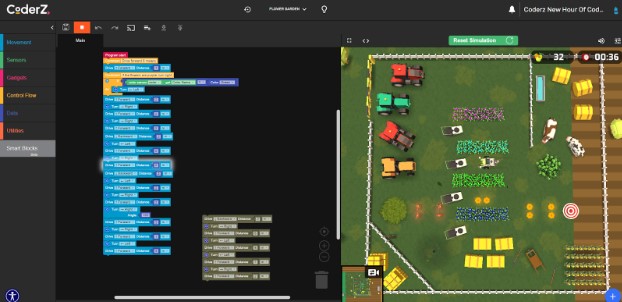Ah coding. For years it has been one of those topics that the students are super interested in and a vast majority of the staff have heard of but have little experience in using, let alone teaching.
Value-Added Learning?
- Technology is present in every industry, and these industries are or will be looking to fill positions.
- Learning to code involves logic, problem-solving, backwards planning, and other broadly applicable thinking skills (Jamie K., commonsense.org), skills that are beneficial in any context.
- Failure, and learning to encounter and deal with it productively.
- Attention to detail, in a more fun, and possibly even more practical sense than showing work in solving math problems, or scouring writing for comma usage.
I like to talk with the students that I teach about things that I am learning through my Grad classes, and they definitely seem to be more engaged with content from this class than organizational theory or policy writing in education. These conversations give me some insight as to what the students that I am working with now are into. In talking about coding, I learned about the accomplishments of one of the students that I see daily!
Challenges May Exist
Would all students benefit from refining their collaboration, creativity, communication, and critical thinking skills? For sure. Would incorporating coding into the classroom come with challenges? Definitely. As Olan Rogers said, “Every good fight needs a few hits.” Not anticipating challenges would be naive, but in the case of using coding in the classroom, it is hard to imagine the cons outweighing the pros.
To be able to actualize coding in the classroom, the initial need is access to devices and the internet. Not every student has their own personal device, and not every school has enough devices for all of the students. I cannot imagine that coding requires a one-to-one device to student ratio, or that the students will need to be on a device so much that they require one all of the time, but when sharing things like tablets or laptops throughout a school, it is definitely something to consider. From the personal device perspective, marginalized individuals would face an even more difficult road, which may stress the importance of offering as much as possible in schools, especially if schools have the financial resources to help build that bridge.
Another segment of students that may struggle with coding are those with reading difficulties. However, as we learned a few weeks ago, Assistive Technology is available and could possibly be available to include those students in using coding in the classroom.
What is holding me back?
Chris Bosh said that coding “can be intimidating, and a lot of things are intimidating, but what isn’t?” I agree with all of that. ALL of it. If I am going to practice what I preach, then I should be getting out of my comfort zone and taking on some coding to build familiarity with the topic. In my limited experience with Minecraft, I have found that students are more than willing to help teach the teacher, and I have become a real member of the collaborative classroom community instead of just a facilitator and overseer.
Leadership and direction on how to incorporate this content into different subject areas is something that I would appreciate from my school division. I mean real leadership and guidance, not just a list of activities or sites to check out. I want to sit down with someone and spend some time getting to know the programs and possibilities available to me, and how I can get coding into ELA, Social, and French. I am excited to attend a Robotics and Coding PD session put on by our school division this week to see what kind of support is available to me.
The lamest reason that I have is time. Perhaps when I finish class number ten, I will dabble in the coding world a little more to build that area of my repertoire.
Coding… For “Techies” Only?
For the record, I was able to program a robot to help with collecting what I can only assume to be radioactive pumpkins. This skill was developed and refined over the course of about an hour. It certainly tested my critical thinking and problem solving skills. Had my 9 year-old son not been in bed, I know that I would have had someone to collaborate with too!


I disagree with this ideas that only “techies” should teach coding. As someone who spent seven years collecting two undergraduate degrees, trained in becoming a specialized teacher (that glorious combination of physical education and history), I have found myself as a generalist for the last ten years. Teaching everything except Band and PAA is not where I saw myself. I have no training in teaching French or Art, yet here I am.
The prospects of coding are appealing considering what I am already teaching in that I can actually go online and learn/teach myself through playing around with the same things that students would be using. The practicality of coding and makerspaces is also valuable. As Makinde said in Code Stars, “It’s more about the process of breaking down problems than coming up with complicated algorithms.” That growth mindset that encourages creativity, critical thinking, and problem solving, especially utilizing the mediums of coding and makerspaces, seems to be more applicable for students. These skills, combined with the collaborative nature are things that I value in coworkers, colleagues, students, and myself, and I am not a “techie” by any stretch.
This week Kirsten, Gilles, and Colton had a really engaging presentation, and within their time limit and task requirements, I was able to reconnect with 8 year-old me over some Lego. I’m not bragging, but through some problem problem solving and creativity, I was able to assemble these beauties, which are not for sale at the request of my son.


Is coding and makerspaces opening doors for our students to be modern day, technological artisans?
I like your point about our students teaching us. I love when we are able to learn together/from each other and not only them learning from me. I enjoy seeing their interests and strengths. When it comes to coding, many of my students know more about it than I do. A few days ago, I gave them the hour of code site to try out when they finished their work. Some of them liked it and some of them were already quite advanced in that area.
Great post Bart! Like you, getting out of my comfort zone has pushed me into some of my most impactful learning. I love your point about the collaborative classroom community- I took one coding class in university, but I’m confident that the students have already taught me more than I learned in that class! Learning alongside the students gives potential for some really effective learning experiences.
Thanks for your thoughts, Bart! I appreciate your thoughts on coding not only being for “techies” and how although you specialized in certain areas, you have had to be flexible and teach in other circumstances. Within Code Stars, I found the points about creativity leads to problem solving, which inevitably helps our students to be one to remember. It was stated, “Coding also provides students with skills that apply across content areas. By learning to tell machines what to do, students engage in problem-solving and computational thinking, which apply to academic and professional disciplines across the board.” For myself, even trying Hour of Code, has unleashed possibilities and opened my eyes to a new world.
I enjoyed reading your post…
I really like the time in classroom when students and teachers works collaboratively… I believe that the knowledge sharing that takes place is very effective learning. Also, coding is not my comfort zone and I have even tried to learn it via traditional methods. But I strongly believe that these websites are way more helpful and interesting.
Thank you for sharing your thoughts!
Yes, it is actually a big challenge that every student should have a device and internet connection. And it’s also not a realistic thought that everyone will have it. I admire this statement and agree that assistive technology can help students use coding in the classroom.